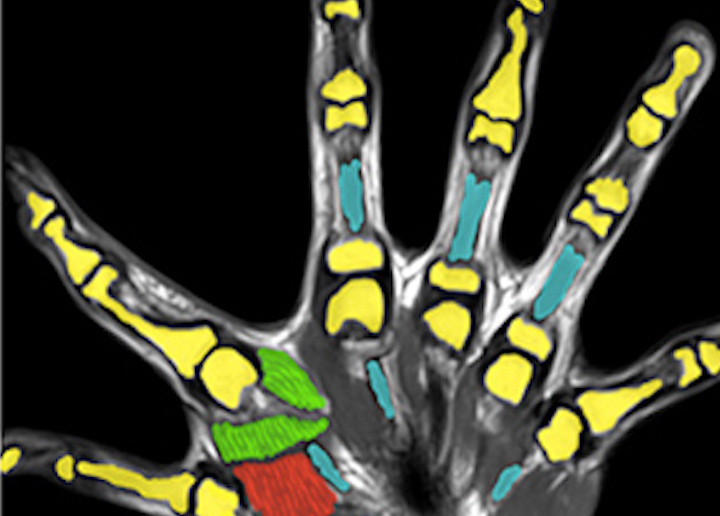Minisymposium "Movement Augmentation with Supernumerary Limbs"
| When |
May 06, 2021
from 10:00 AM to 11:40 AM |
|---|---|
| Where | International Virtual Meeting |
| Contact Name | Carsten Mehring |
| Add event to calendar |
|
Organizers
Prof. Dr Etienne Burdet, Imperial College London, United Kingdom
Dr Jonathan Eden, Imperial College London, United Kingdom
Prof. Dr Dario Farina, Imperial College London, United Kingdom
Prof. Dr Carsten Mehring, University of Freiburg, Germany
Synopsis
An artificial limb that acts with little cognition and can be controlled concurrently to my arms is a common science fiction vision. If made true, it would transform life by enabling us to perform tasks that are otherwise impossible. Surgeons could control added surgical tools, using a mouse without my fingers would allow me to handle virtual objects or run apps on my phone while holding luggage, etc. Neural engineering will be pivotal to making this vision reality by developing bidirectional interfaces, wearable supernumerary limbs (SLs) and algorithms for adaptive SL sensorimotor control.
This symposium will present recent results from leaders in the emerging field of movement augmentation and SLs. Mehring (Uni Freiburg) and Burdet (Imperial College London, ICL) conducted the first study into the abilities of humans with 6 fingers (Nature Commun. 2019). This showed that the motor system can control extra dof without sacrificing from elsewhere, suggesting the capability for intuitive/efficient SL control. Mehring is a brain-computer interface (BCI) and neuroscience expert (Nature Neurosci. 2003, Nature Commun. 2018) who recently displayed the first invasive BCI to control an artificial effector concurrently/coordinated with hand movements (J Neural Eng. 2018). Burdet is a leader in human robotics (Nature 2001, Nature Hum Behav 2017, Nature Mach Intell. 2019) who developed the first body interface to control a 3rd arm (Sci Rep. 2016). Farina (ICL) made the first demonstration of interfacing individual motor neurons in humans following nerve transfers (Lancet 2015, Science Robotics 2019). Di Pino (U Campus BioMedico di Roma) developed pioneering activity in computational neuroscience and embodiment for neural interfaces and prostheses (Science Transl Med. 2014, Science Robotics 2019). Jarrassé (Sorbonne) is a leader in the design and control of prostheses and the sociology of SLs (Sci Rep. 2017). Stelarc (http://stelarc.org) is a performance artist well-known for his explorations of the extension of the human body’s capability.
Detailed Program [click here]
Schedule
Chair: Mehring, Carsten, University of Freiburg
10:00-10:20, Paper ThA3.1
Movement Augmentation with Natural and Artificial Supernumerary Effectors
Mehring, Carsten, University of Freiburg
10:20-10:40, Paper ThA3.2
Trimanipulation with Body Interfaces
Huang, Yanpei, Imperial College London
Eden, Jonathan, Imperial College London
Burdet, Etienne, Imperial Collge of Science, Technology and Medicine
10:40-11:00, Paper ThA3.3
Voluntary Decoupling of Low-Frequency and Beta Band Power in Motoneuron Behavior
Bracklein, Mario, Imperial College London
Ibáñez, Jaime, Institute of Neurology, University College London
Barsakcioglu, Deren Yusuf, Imperial College London
Farina, Dario, Imperial College London
11:00-11:20, Paper ThA3.4
An Intuitive Control for a Wearable Supernumerary Robotic Limb
Jarrassé, Nathanael, Sorbonne Université, ISIR UMR 7222 CNRS
Poignant, Alexis, Sorbonne Université, ISIR UMR 7222 CNRS
Legrand, Mathilde, Sorbonne Université, ISIR UMR 7222 CNRS
Khoramshahi, Mahdi, Sorbonne Université, ISIR UMR 7222 CNRS
Morel, Guillaume, Université Pierre Et Marie Curie - Paris 6
11:20-11:40, Paper ThA3.5
Cartesian Space Feedback for Real Time Tracking of a Supernumerary Robotic Limb: A Pilot Study
Pinardi, Mattia, Campus Bio-Medico University of Rome
Raiano, Luigi, Unit of Biomedical Robotics and Biomicrosystems, Department of E
Noccaro, Alessia, Università Campus Bio-Medico Di Roma
Formica, Domenico, Campus Bio-Medico University
Di Pino, Giovanni, Campus Biomedico University
More about the Conference:
May 4-6, 2021, Virtually


